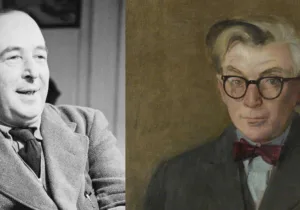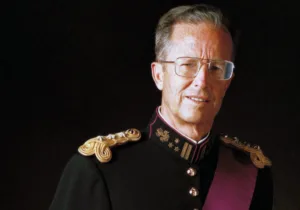“This only son died that other sons might live in love and peace.”
So reads an inscription inside St. Maurice Church in the tiny and otherwise unremarkable village of Eschweiler, Luxembourg. Here, these words describe not only the Son of God but another son, one tied to this town and to this church, by fate or Providence, many years ago. That son is US Army Private George Mergenthaler.
I came to know the story of George Mergenthaler this fall while touring the sites of historic World War II battles. And this Christmastime, I’m thinking about George.
After enlisting in the US Army, George Mergenthaler of Rye, NY, found himself billeted in Eschweiler in November 1944, along with his fellow soldiers in the 28th Reconnaissance Troop (Mechanized) of the 28th Infantry Division. Mergenthaler, fluent in French and German, “endeared himself to the people of the small farming town,” where together they “shared meals, church services, hopes, and dreams,” as former Congressman Eliot Engel recalled in a 2019 speech honoring Mergenthaler in the US House of Representatives.
One would not be faulted for not placing Eschweiler on a map. It lies on a plateau in the Ardennes Forest a few miles east of Bastogne, Belgium, a well-known mecca of sorts for World War II history buffs. Beginning in mid-December in 1944, American soldiers dug in against Nazi Germany’s last-ditch offensive in the west in what is now known as the Battle of the Bulge. The story of the 101st Airborne Division in Bastogne has achieved near-mythic status, in no small part because of Brigadier General Anthony McAuliffe’s iconic response to the German surrender ultimatum—“NUTS!”—and the story of the siege in Stephen Ambrose’s best-selling book Band of Brothers and the hit HBO miniseries of the same name.
Two days into the surprise offensive, German soldiers ambushed Mergenthaler’s unit as it maneuvered to defend the town. Manning a .50-caliber machine gun mounted in the back of a jeep, Mergenthaler laid down covering fire to allow the other Americans to escape before the gun jammed. Twenty-four-year-old George Mergenthaler was killed in action on December 18, 1944—77 years ago this month.
But Mergenthaler’s story did not end there.
Unbeknownst to his fellow soldiers, Mergenthaler was the sole heir to a family fortune. His grandfather, Ottmar Mergenthaler, who had emigrated from Germany, invented the Linotype machine that had gone on to revolutionize the printing industry. When the townspeople discovered Mergenthaler’s body, the local priest buried the young American GI in the parish cemetery—as if he were one of their own—and wrote to Mergenthaler’s parents. Alice and Herman Mergenthaler responded to their only son’s death not with bitterness but with charity.
After the war, the Mergenthaler family sent funds to Eschweiler to restore the damaged church that had provided a small measure of comfort to their son. And it is through this legacy rooted in shared suffering and loss that I came to encounter George’s story.

As you make your way up the nave in St. Maurice’s—which, as it happens, is named after another slain soldier—an amber-colored stained-glass panel displays both the Great Seal of the United States and the Mergenthaler family crest. To the right of the main altar, a mural depicts the feeding of the 5,000. A young disciple donning a dark cloak over an olive-green Army uniform distributes the loaves. His face is George Mergenthaler’s. As you exit the church, a bas-relief of George’s face, coupled with the aforementioned description, completes the tribute. Standing in this church, President Abraham Lincoln’s words in his Letter to Mrs. Bixby seem altogether fitting.
To some, the iconography may seem contrived. I would like to think that in honoring Mergenthaler in this unique way, the people of Eschweiler honor the scores of American soldiers who died for the cause of liberty in Europe. Indeed, throughout Belgium and Luxembourg simple stone monuments adorn numerous town squares honoring these liberators to this day.
This spirit of gratitude and remembrance thousands of miles from home—and many decades hence—should inform how we Americans contemplate why our nation is an exceptional one and why American leadership is worth sustaining.
Yet according to a recent Harvard Youth Poll, only one-third of 19- to 29-year-olds now believe in American exceptionalism. Equally concerning, one-third of Americans under the age of 30 want the United States to be less engaged on the world stage, according to a survey from the Ronald Reagan Institute. The survey also found that less than half of Americans place a great deal of trust or confidence in the US military—down from 70 percent just three years ago.
Are we so ready to abandon our American ideals that have inspired so many? Are we prepared to risk discovering who and what will fill the vacuum in the absence of American leadership?
President Reagan himself spoke to this enduring responsibility—and about George Mergenthaler’s story—when he visited Luxembourg in 1984, marveling at the “deep bond formed between the people of that ancient village and the amiable young Yankee.”
Perhaps the church tribute to Mergenthaler resonated with me for the same reasons it resonated with Reagan all those years ago. Mergenthaler’s story, demonstrative of the lasting power of American values, compels the visitor to confront these questions—and to contemplate how this slain soldier and his fellow brothers-in-arms would have answered them.
This Christmastime, we would all do well to remember the story of Private George Mergenthaler and to honor his legacy by rediscovering this sense of duty and pride.






 Live in the DC area? Sign-up for Providence's in-person events list!
Live in the DC area? Sign-up for Providence's in-person events list!